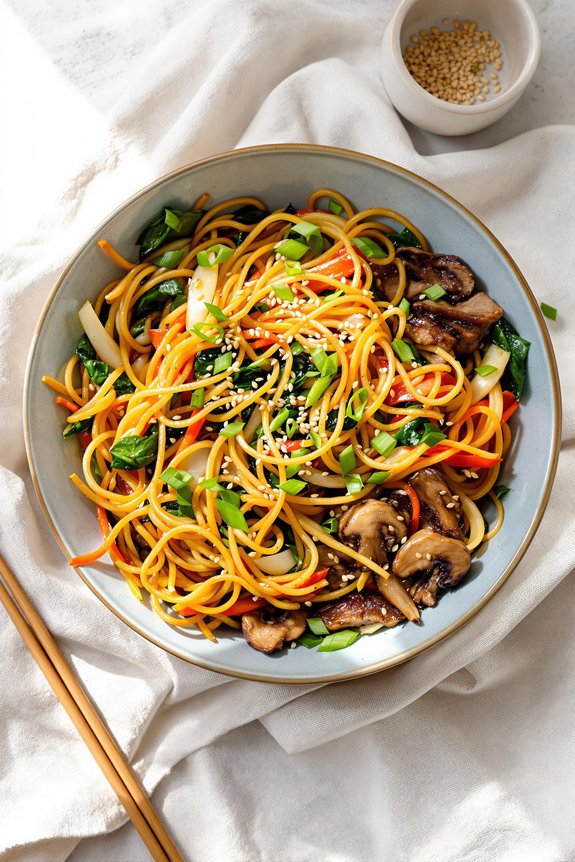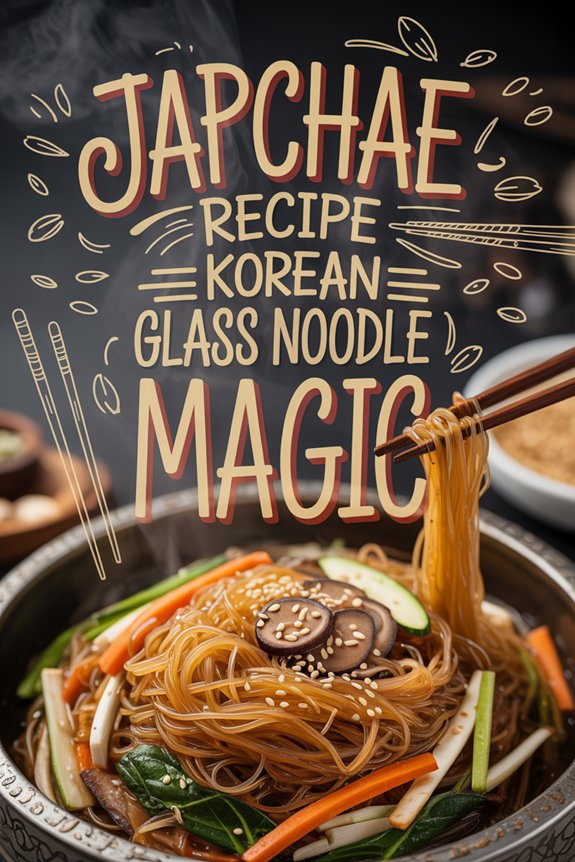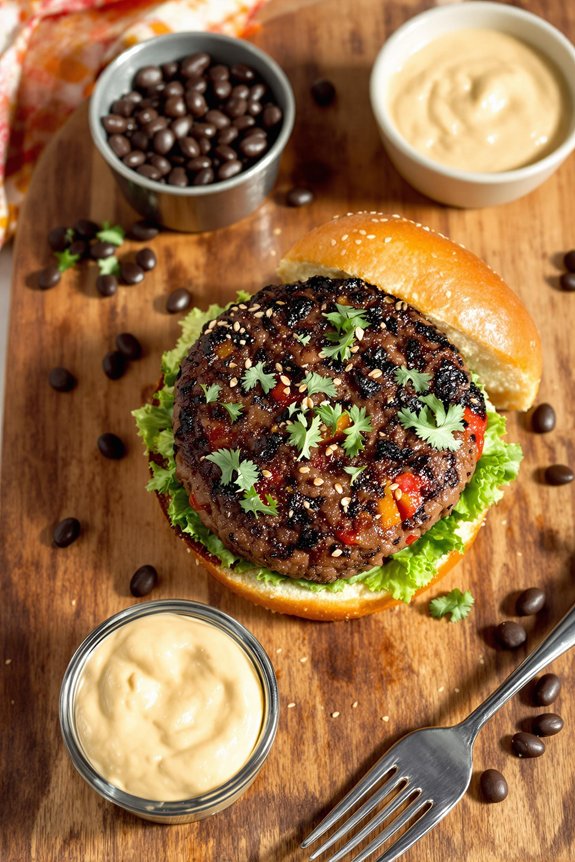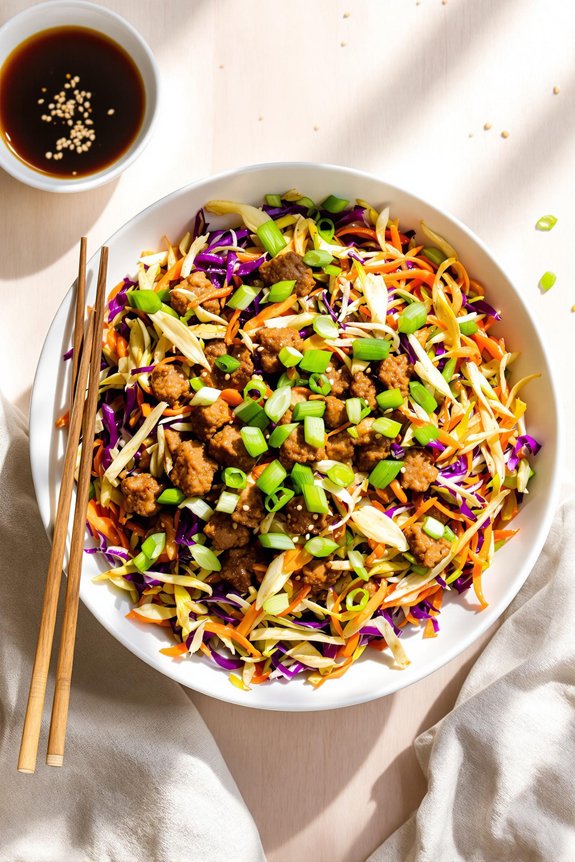Why You’ll Love this Korean Glass Noodle Japchae
Why do home cooks constantly search for that perfect balance of healthy, flavorful, and impressive? I think japchae might be your answer.
These glossy, bouncy sweet potato noodles absorb all the savory-sweet flavors while mingling with colorful veggies and tender beef. It’s a dish that sparkles with sesame oil and soy sauce, creating that umami magic we crave.
What really sells me on japchae is its versatility—serve it hot for dinner or cold for lunch.
The rainbow of ingredients (spinach, carrots, mushrooms) means you’re getting nutrition without sacrifice. And those chewy noodles? Completely addictive.
What Ingredients are in Korean Glass Noodle Japchae?
Japchae brings together the perfect balance of textures and flavors in one colorful dish. At its heart are the distinctive sweet potato starch noodles (dangmyun), which have that signature chewy bounce that makes this dish so craveable.
The combination of protein, vegetables, and aromatics creates a symphony of tastes that somehow manages to be both comforting and elegant. Let’s break down exactly what you’ll need to create authentic japchae at home.
- 150g Korean sweet potato starch noodles (dangmyun)
- 150g beef, thinly sliced
- 1 bunch spinach
- 1 medium carrot, cut into thin matchsticks
- 1 medium onion, thinly sliced
- 5 dried shiitake mushrooms
- 2 cups sliced white mushrooms
- 3 garlic cloves, minced
- 7-8 green onions, cut into 7cm pieces
- 4 tablespoons soy sauce (divided)
- 4 tablespoons sesame oil (divided)
- Olive oil for stir-frying
- 3 tablespoons sugar
- 1 teaspoon black pepper
- 1 tablespoon toasted sesame seeds
The beauty of japchae lies in its flexibility—you can adjust ingredients to suit your preferences or what you have on hand.
Don’t eat beef? Skip it for a vegetarian version or substitute with tofu. Can’t find dried shiitake mushrooms? The fresh white mushrooms will still provide plenty of earthy flavor.
The key non-negotiables are the dangmyun noodles (available at Asian markets) and the sesame oil, which gives the dish its characteristic nutty aroma.
Remember that each ingredient is cooked separately to maintain its distinct texture and color, creating that gorgeous mosaic effect that makes japchae such a showstopper on any table.
How to Make this Korean Glass Noodle Japchae
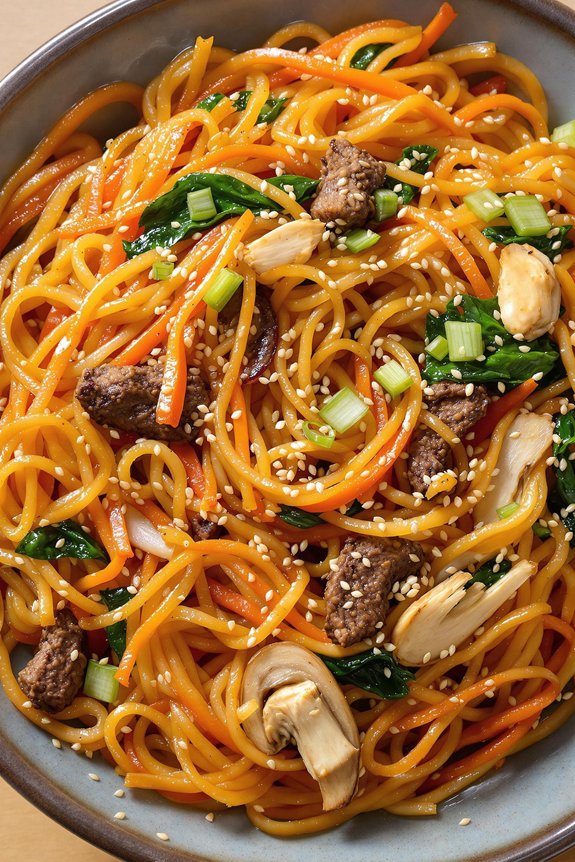
Making japchae is all about respecting each ingredient and giving it the attention it deserves. Start by soaking 5 dried shiitake mushrooms in warm water for a few hours until they’ve softened completely. Once they’re plump and yielding, squeeze out the excess water and slice them into thin strips.
Meanwhile, boil 150g of Korean sweet potato noodles (dangmyun) for about 3 minutes until they’re soft but still slightly chewy. Drain them, transfer to a large bowl, and cut them into more manageable lengths with scissors. Immediately toss the noodles with 1 tablespoon of soy sauce and 1 tablespoon of sesame oil to prevent sticking and begin building that signature flavor.
Now comes the methodical dance of cooking each component. Using the same pot of hot water, blanch 1 bunch of spinach for just a minute, then rinse it in cold water three times to stop the cooking process and preserve its vibrant green color. After squeezing out the excess moisture, cut the spinach into 5cm pieces and season with ½ tablespoon each of soy sauce and sesame oil.
For the remaining vegetables, you’ll use a hot pan with just a few drops of olive oil for each: stir-fry the matchstick carrots for 30 seconds, cook the thinly sliced onion until translucent, briefly sauté 2 cups of sliced white mushrooms, and cook the green onions for about a minute. The beef strips get cooked with the sliced shiitake mushrooms, 3 minced garlic cloves, ½ tablespoon soy sauce, and ½ tablespoon sugar until everything is perfectly cooked through and aromatic. For an authentic touch, consider using a premium Turkish set that distributes heat evenly and enhances the flavors of your japchae ingredients.
The final assembly is where the magic happens. Add all your separately cooked ingredients to the bowl with the noodles, then season with the remaining 2 tablespoons of soy sauce, 3 tablespoons of sugar, 2 tablespoons of sesame oil, and 1 teaspoon of black pepper.
Gently toss everything together until the noodles are glossy and each ingredient is evenly distributed throughout. Can you imagine the aroma at this point? The nutty sesame oil, the savory soy, the sweet-and-salty balance that makes Korean food so addictive?
Finish with a generous sprinkle of 1 tablespoon toasted sesame seeds on top, which adds both visual appeal and a lovely crunch to contrast with the chewy noodles. This careful layering of flavors and textures is what makes japchae a perennial favorite at Korean tables, from everyday meals to special celebrations.
Korean Glass Noodle Japchae Substitutions and Variations
While the traditional japchae recipe is undeniably delicious, there’s plenty of room for adaptation based on what you have in your pantry.
No dangmyun noodles? You can substitute with sweet potato starch noodles or even soba in a pinch.
Vegetarians might skip the beef entirely or replace it with tofu or tempeh for protein.
Don’t have shiitake mushrooms? Regular button mushrooms work fine, though you’ll miss that distinctive earthy flavor.
And when it comes to veggies, the sky’s the limit—bell peppers, bok choy, or zucchini all make wonderful additions.
Just maintain that balance of sweet, savory, and sesame.
What to Serve with Korean Glass Noodle Japchae
Now that you’ve mastered making your own japchae with whatever ingredients you have on hand, let’s talk about how to turn this stunning dish into a complete meal.
I love serving japchae alongside kimchi for that perfect tangy contrast.
Korean barbecue dishes like bulgogi or galbi make incredible companions, creating that authentic Korean table spread.
For a simpler meal, pair it with steamed rice and a light soup.
Vegetarians can add pan-fried tofu or more mushrooms for protein.
Want it as a standalone? Just increase the beef or add an egg on top.
The vibrant colors alone make it worthy of being your centerpiece dish.
Final Thoughts
After you’ve sampled your first forkful of this colorful, savory japchae, you’ll understand why it’s become such a beloved dish worldwide.
There’s something magical about the way those springy glass noodles soak up all those delicious flavors while maintaining their distinctive chew.
What I love most about japchae is its versatility.
Don’t have shiitakes? Regular mushrooms work beautifully.
Vegetarian? Skip the beef and double up on veggies.
The balanced combination of sweet, savory, and nutty notes creates a dish that’s both comforting and impressive—perfect for any occasion, from quiet weeknight dinners to festive gatherings.

